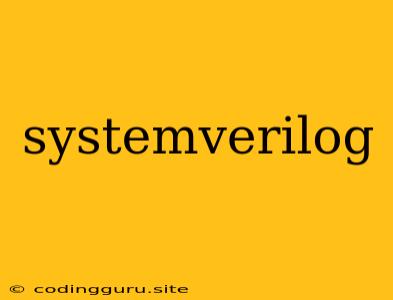SystemVerilog: The Powerhouse of Hardware Verification
SystemVerilog is a Hardware Description Language (HDL) widely used in the design and verification of digital circuits and systems. It's a powerful language offering a comprehensive set of features for modeling, simulating, and verifying complex hardware designs. But what exactly makes SystemVerilog so potent and what are the benefits of using it? Let's dive in.
Why SystemVerilog?
SystemVerilog emerged as a natural evolution from Verilog, building upon its strengths while addressing its limitations. Here are some key reasons why SystemVerilog stands out:
-
Enhanced Verilog Capabilities: SystemVerilog inherits the core functionalities of Verilog but enhances them significantly. It provides more powerful data types, constructs for advanced modeling, and sophisticated verification methodologies.
-
Object-Oriented Programming (OOP): SystemVerilog incorporates OOP principles, allowing for code reuse, modularity, and better organization. This enables efficient and scalable design and verification processes.
-
Advanced Verification Techniques: SystemVerilog offers a wealth of features for creating robust and efficient verification environments. These include:
- Assertions: Assertions allow you to formally specify expected behavior, making it easier to identify and debug design flaws.
- Coverage: SystemVerilog provides coverage groups and coverage points, helping you measure the effectiveness of your verification process.
- Randomization: SystemVerilog's randomization capabilities allow you to generate random test cases, increasing the coverage of your verification.
- Functional Coverage: This allows you to track and measure the coverage of specific functionalities within your design.
-
Industry Standard: SystemVerilog is widely adopted across the electronics industry. It's supported by leading EDA (Electronic Design Automation) tools, ensuring seamless integration with existing workflows.
Understanding SystemVerilog Basics
-
Data Types: SystemVerilog offers a rich set of data types, including:
- Integer: Represents signed integers.
- Real: Represents floating-point numbers.
- Logic: Can hold values of 0, 1, X (unknown), and Z (high impedance).
- Reg: A variable that holds a single value.
- Wire: A connection between modules or components.
- Memory: Represents an array of elements.
-
Modules: Modules are the fundamental building blocks of SystemVerilog designs. They encapsulate logic and behavior.
-
Tasks and Functions: Tasks and functions allow you to create reusable code blocks.
-
Operators: SystemVerilog supports a variety of operators, including arithmetic, logical, bitwise, and relational operators.
-
Control Flow: SystemVerilog includes control flow statements like
if-else,case,for, andwhileto create dynamic behavior. -
Concurrency: SystemVerilog is a concurrent language, meaning that multiple processes can run simultaneously. This is achieved through constructs like
alwaysblocks andinitialblocks.
Building a SystemVerilog Verification Environment
Creating an effective verification environment is crucial for ensuring the correctness and robustness of your design. Here are some key elements:
-
Testbench: The testbench is the heart of your verification environment. It's responsible for generating test cases, simulating the design, and verifying its behavior.
-
Stimulus Generation: The testbench must generate stimuli that exercise all aspects of your design. This may involve generating random data, simulating specific scenarios, or using pre-recorded test cases.
-
Verification Components: SystemVerilog allows you to create specialized verification components like:
- Scoreboards: Scoreboards track expected outputs and compare them to actual outputs from the design.
- Monitors: Monitors observe and record signals within the design, providing valuable insights into its behavior.
- Coverage Groups: Coverage groups help you track and measure the effectiveness of your test cases.
-
Assertion-Based Verification (ABV): Assertions provide a powerful way to formally specify the expected behavior of your design. They can be used to detect errors during simulation or formal verification.
Tips for Effective SystemVerilog Usage
-
Plan and Organize: A well-structured design and verification environment will make your development process much smoother.
-
Use OOP Effectively: OOP principles can help you create modular, reusable, and well-organized code.
-
Start with Assertions: Develop assertions early in the design process to define the expected behavior and identify potential issues early on.
-
Employ Coverage Analysis: Use coverage groups and coverage points to track the progress of your verification and ensure comprehensive testing.
-
Leverage Randomization: Randomization can help generate diverse test cases, improving the overall coverage of your verification process.
SystemVerilog Resources
- SystemVerilog LRM (Language Reference Manual): The official document defining the language syntax and semantics.
- Online Tutorials and Courses: Many online resources offer comprehensive tutorials and courses on SystemVerilog, covering various aspects of the language.
- SystemVerilog Books: Several books delve into different aspects of SystemVerilog, from basics to advanced topics.
Conclusion
SystemVerilog is a powerful and versatile language that has become the industry standard for hardware verification. Its advanced features, including OOP, assertions, coverage, and randomization, enable the creation of robust and efficient verification environments. By understanding and effectively using SystemVerilog, you can build complex digital circuits and systems with confidence, ensuring their correctness and reliability.
